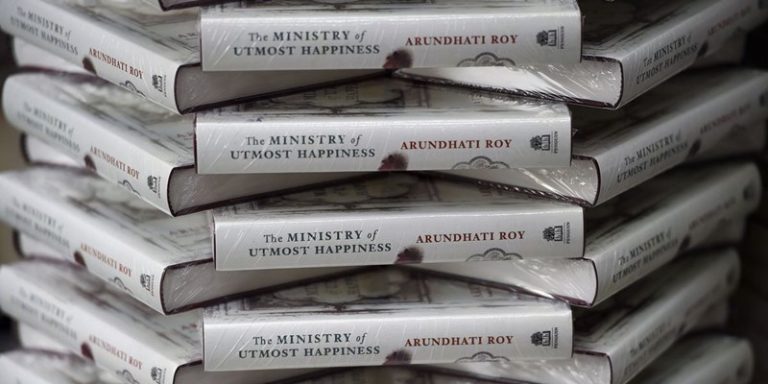Anannya Nath reviews The One Legged by Sakyajit Bhattacharya, translated from Bangla by Rituparna Mukherjee (published by Red Herring, The Antonym Collections, 2023).
The trees swayed in the soft breeze of the quiet night, and among the shadows of the tall trees was the outline of a ruined dome. The air whistled through its cracks and crevices.
– Sakyajit Bhattacharya, The One Legged
Sakyajit Bhattacharya’s Ekanore (Saptarshi Prakashan, 2022) is a tale about loss, longing, and love. Translated into English by Rituparna Mukherjee as The One Legged, it revolves around the child Tunu and his desire to fill the gaping hole in his life—one devoid of love and care. The lore of Ekanore—the one-legged mythical creature who feasts on children’s ears—is radically transformed into a narrative of societal vices that corrupt people without permission.
Recommended Reading: The Middleman by Mani Sankar Mukherjee
The elements of gothic fiction, with an underlying sense of the uncanny, bring the story closer to what is called ‘speculative fiction.’ However, as the translator notes, it defies any watertight generic categorisation. Within the praxis of the speculative, then, the story raises questions both of morality and conscience.
Characterisation and Uncanny
Bhattacharya’s characterisation in The One Legged is built around the existence of the uncanny. Every character hides an afflicting truth and, in hiding their truths from the purview of others, ends up being disloyal to their own reality. Tunu, the protagonist, is a loner whose afflictions are rooted in his childhood sans parental care. As the narrative progresses and his actions come into play, one is reminded how easy it is for vice to breed when children stop being childlike.

Left alone, Tunu becomes his own playmate and confidant, and together, they play, converse and critique. What is interesting here is the choice of infantile diction to narrate Tunu’s monologues. In one of the many moments when Tunu finds that he has libidinal inclinations for Rima Mami, he is quick to chastise himself for his “bad” thoughts. Mukherjee’s translation captures the nuances in diction that vary depending on who is talking or thinking with artistic ease.
On the other end of the story is Ekanore, the diabolical spirit that resides atop a palm tree. But Ekanore’s characterisation is symbolic and can only be realised in context. This supernatural entity exists in every shape and form, breathing and pulsating like the fungus-strewn wall in Choto Mama’s room, reiterating that evil is organic and grows when unattended, corrupting minds and blurring all lines of morality. Resident in its spectral attire, Ekanore does not lose a leg but acquires two more.
Recommended Reading: Discover the sweetest state of India with these Bengali books
With one leg, it steps upon a person’s conscience. The other leg stomps over relationships by expanding rifts extant in class and caste, while yet another presses on the feelings of envy and anger, clearing ground for ungodly actions. In this way, Ekanore creates a karmic labyrinth no Icarus can escape from.
The Sinister Backdrop in The One Legged
The setting of The One Legged is as unsettling as the breathlessness of its pace. The solitary Ghosh mansion, the yard that extends forever, livid storks taking up the entire geography of the jungle, Choto Mama’s organised room as if occupied by his presence, the abandoned dome in the forest and the ageless palm tree standing sentry to the mansion are all images that accentuate the gothic and keep the readers hooked till the very end. The setting has an organicity of its own, occupying space and living alongside the characters.
Recommended Reading: Glory and Decadence: Narach by Debarati Mukhopadhyay, now in English
The distortion in the narrative comes from the temporal aspects of the backdrop. Time tears into the fabric of space, assimilating the setting of the past and the present into one composite whole. People grow up and die, but the macabre aura lingers from one generation to the next, unchanged. Thus, when Tunu appears on the scene, the setting merely gains a new momentum. Otherwise, it has always witnessed several incidents of grotesque for years longer than Tunu’s entire existence. In fact, the setting binds time into an equilibrium of sorts. That’s why Tunu and his Choto Mama, despite never meeting each other corporally, are deeply connected to the uncanny that resists temporality.
The Art of Translation
In her Translator’s Note, Rituparna Mukherjee writes about the challenge of translating ‘suspense,’ about the fragile art of executing and retaining lyrically the ‘essence’ of one language in another, yet she does it successfully. While translating The One Legged from Bengali into English, she uses words that conjure not just the fantastical elements but also a ubiquitous sense of grief, ensuring nothing is lost while translating. While English occupies a privileged position in its asymmetrical power relation with the Indian Bhashas, it is the translator’s creativity that contains the story seamlessly within the precinct of the foreign language.
Recommended Reading: Tales of a Voyager – Travel, Adventure, and Learning
Despite the translation’s English lexicon, it is easily discernible that The One Legged is rooted in the mythical Bengali world. Unlike many translators who use ‘foreignization’ while writing in English, keeping the source language words intact in the target language, usually by italicising the source word to mark its non-English character, Mukherjee does away with this distinction while addressing relations like ‘Dida,’ ‘Choto Mama,’ and ‘Dada,’ thereby blurring lexical hierarchy. Words which are densely localised, however, are italicised to earmark their specificity within the culture and, unlike uncles, brothers, and grandmas, are not universal. And so, the local gods and deities like Panchu Thakur and Jwarasura stand out.
Favourite Quote from The One Legged by Sakyajit Bhattacharya
Tunu had once seen a kite, broken from the thread that anchored it, meandering amidst the dense black clouds in the force of the wind and subsequently vanishing. He had feared for the kite then, alone in the dark, noisy clouds. The vitality of this house had similarly settled itself atop the palm tree, dissipating in atoms and molecules among the cluster of its leaves in these disconsolate evenings.
Conclusion
Longlisted for the JCB Prize for Literature 2024, The One Legged has a fascinating aftertaste that lingers long in memory. However, for a gothic narrative, the catharsis is not fear-inducing but deeply poignant, as the reader remains parched for a world beyond the story’s frame. The open-ended resolution restates that poignancy is inconclusive, and despite suffering once, one can suffer again.
What begins as a story of a boy navigating through the murky waters of loneliness transforms into a story about human suffering in general. The author and the translator have outdone themselves, creating similar worlds in two languages that inform each other while reinforcing that regional literature is never parochial, nor is translation subservient to the language a text is first written in.
Have you read this gothic novel where loss, love, and the uncanny intertwine, transcending language barriers? We’d love to hear your opinions! Share them with us by commenting below.























